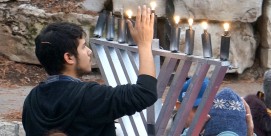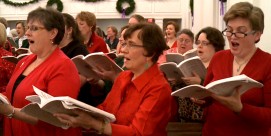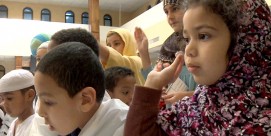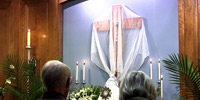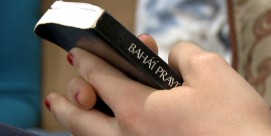In This Episode << SLIDE LEFT TO SEE ADDITIONAL SEGMENTS
Passover Seder: Why Is This Book Different from All Other Books?
by Juliana Ochs and Missy Daniel
For over 50 years, a family of New York City philanthropists has commissioned prominent artists to interpret Passover themes for the extended family’s annual seder, and now some of the remarkable results are available for all to see at the New York Public Library.
Since 1947, the descendents of Joseph and Anna Rose and Samuel and Belle Rose have accumulated three bound volumes of art inspired by texts of the Passover haggadah, a compilation of biblical passages, hymns, prayers, and rabbinic writings assembled to be read during the seder, the ceremony held in Jewish homes to commemorate the Israelites’ Exodus from Egypt in biblical times.

|

|

|

|
“As a child, it was always a secret who the artist was going to be,” says Emily Rose, who lives in Cambridge, England. “When you walked into the seder it was not just to see family and friends, but to see what passage was chosen and what the illustrations were.” To this day, an important part of the family’s Passover experience is leafing through the different volumes and looking over all the past guests’ signatures.
For generations, Jewish artists have lavished illustrations and illuminations on Passover haggadahs, and the Rose family’s illustrated seder book has served as a great enrichment of its traditional Reconstructionist haggadah. “On one hand we have the same haggadah every year. It has stick illustrations; it is very plain,” says Emily Rose. “On the other hand, we have the seder book. It always highlights a particular theme or interpretation.”
Each year the chosen artist is different. In 1979 the illustration for the seder book featured Ellis Island and immigration. Representational painter Harvey Dinnerstein contributed an image of the Statue of Liberty and in the distance the Twin Towers of the World Trade Center, accompanied by lines from the Sim Shalom, a prayer for peace: “Bless our country that it may ever be a stronghold of peace and its advocate in the council of nations. May contentment reign within its borders.”

|

|

|
The Rose seder book illustrates how modern haggadahs have often reflected contemporary Jewish agendas and events. One contribution that stands out for Emily Rose is a 1972 image by David Levine, best known for his literary and political caricatures for THE NEW YORK REVIEW OF BOOKS, who did a drawing of former Israeli prime minister Golda Meir serving the seder table, along with some lines from the haggadah: “Behold, this is the bread of affliction… Let all who are hungry come and eat.” In addition to Meir, Levine drew former Israeli defense minister Moshe Dayan and David Ben-Gurion, the first prime minister of the modern state of Israel, who is depicted as a latter-day Moses.
“Three things come together in these volumes,” says Emily Rose’s father Daniel, a real estate developer and senior member of the family who lives in New York City. “Graphic arts, the Rose family’s love for books, and the Jewish tradition.” In 1974, graphic artist Leonard Baskin’s watercolor contributions to the family seder book highlighted Hebrew verses from the Song of Songs that are read liturgically during Passover to celebrate regeneration and the return of spring. A decade later, minimalist painter and sculptor Frank Stella’s collages for the seder book included one that gave prominence to a line from 19th-century German poet Heinrich Heine: “Ever since the Exodus, freedom has spoken with a Hebrew accent.” And in 1994, the seder book featured striking black-and-white photographs by Joan Roth, known for her pictures of Jewish women around the world.
The illustrated book has been a way to introduce creativity, change, and interpretation into the seder, says Emily Rose. “That to me is the Jewish tradition. We have tradition, and then we reinterpret it every year.” Reinterpretation was the theme for New York-based artist and illustrator Mark Podwal’s playful 1981 pen-and-ink drawing of the letters of the Hebrew alphabet literally dancing off a Torah scroll onto the pages of an English-language haggadah — and then off again. The lively line drawing is accompanied by these words: “The Torah is a living document and must be reinterpreted to each generation in its own idiom, in the language and culture of the time.”
Michael Terry, chief librarian of the Dorot Jewish Division at the New York Public Library and curator of the library’s exhibition of Passover-related manuscripts, books, and prints, of which the Rose family’s seder book is a part, says that the Passover ritual “is all about representation — representing the defining moment in Jewish history through speaking, singing, acting, and as far back as the most primitive Passover gesture of all, smearing a lamb’s blood on the doorposts through painting.” The object of a seder, he says, is “to visualize and re-create a sense of participation.” The Rose seder book both reinforces that participation and serves as an aesthetic endorsement of the participants’ religious and spiritual attachments — an expression of the belief that “this is my God, and I will beautify him,” says Terry.
Each of the commissioned artists also creates a sign-in page for the family, another part of the family’s Passover tradition. As guests arrive at the seder, “Everyone signs in, no matter how young,” says Rose. “The seder book illustrates the richness of the tradition visually” she adds. “It’s about the multiple ways one can interpret the haggadah.” Because of the range of the artists’ relation to Judaism and their varying understandings of Passover, says Rose, “It’s a very liberating book” — not unlike the Exodus story itself.
Juliana Ochs is a doctoral candidate in social anthropology at the University of Cambridge, where she is a Gates Cambridge scholar. Missy Daniel is an editor at RELIGION & ETHICS NEWSWEEKLY.

